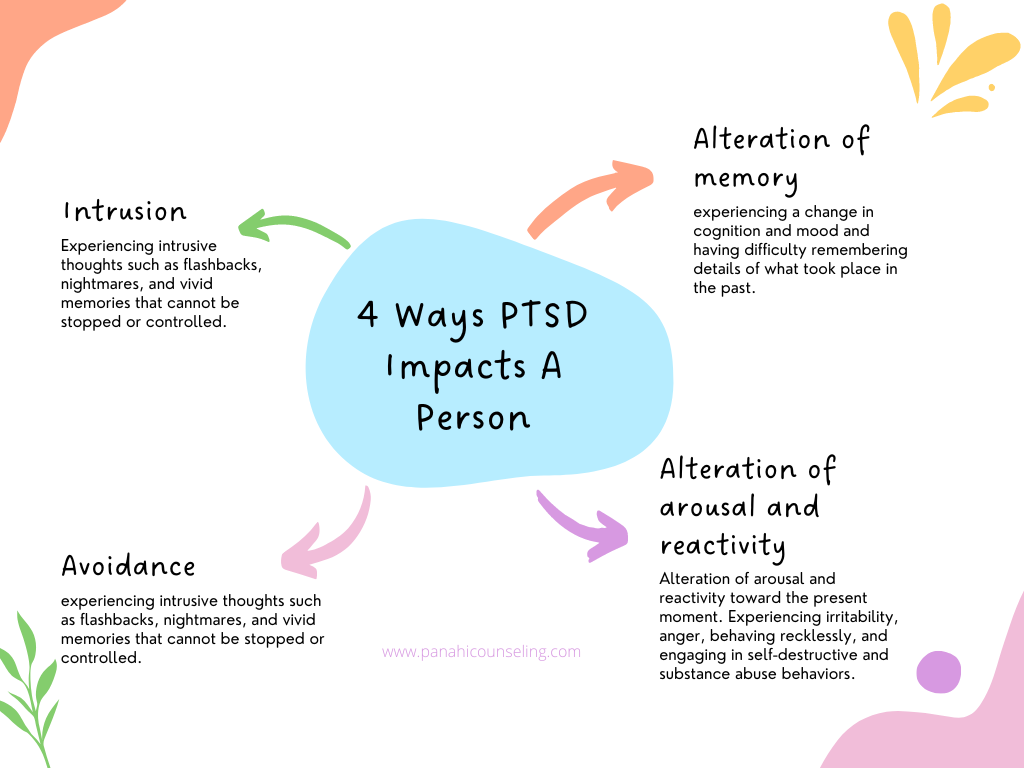At one point in your life, everything seemed normal. You could go about your day without impending doom and fear of avoiding places and situations. But nowadays, it is not the same. Your brain is playing tricks on you, making you think that someone is following you or something terrible is going to happen. In short, it might feel like you’re going mad. If this describes your journey, I want you to know that you are not mad but suffering from Post-Traumatic Stress Disorder (PTSD).
So what is PTSD?
In a nutshell, any traumatic experience left untreated will eventually turn into PTSD in the long run. PTSD has four categories according to the DSM-5 manual used to diagnose someone with PTSD. See the below diagram showing each symptoms of PTSD.

Why am I not getting better?
There are a few reasons why your PTSD is not getting better. They are mostly related to the four mentioned points. Let’s learn each of them.
- Unprocessed memories interfere with your daily life. We now know that traumatic memory is processed and stored differently than standard memory. It is rather stored as disorganized and vague in the form of snapshots. In your daily life, they might pop up unwittingly, tend to be vivid, and make you feel like you are losing your mind.
- Avoiding people, places, and situations is a strategy to keep oneself safe from traumatic memories. Loud noises, unpredictable movements, and particular taste, smell, and touch can remind us of a traumatic experience. Therefore, trauma survivors may try to control their surroundings as much as possible.
- Unhelpful beliefs about the trauma can cause a significant problem for the survivor. Most trauma survivors experience feelings of shame, self-blame, guilt, and anger toward their experience. This often causes the survivor to think they deserved what happened to them. It is also common for the survivors to protect or excuse the behavior of the perpetrators.
Treatment of PTSD
There is a wide range of treatments offered for PTSD. Some well-known and well-researched treatments are Cognitive Behavior Therapy (CBT), Eye Movement Desensitization and Reprocessing (EMDR), and Medication treatment.
- Cognitive Behavior Therapy (CBT) addresses the individual’s cognitive processing toward their trauma, engages in exposure therapy, and teaches the client stress inoculation techniques.
- Eye Movement Desensitization & Reprocessing (EMDR) is one of the most researched approaches for trauma & PTSD. It is recommended as a primary type of treatment by the VA. To learn more about EMDR, consider reading How Does EMDR Therapy Works?
- Medication can help control the symptoms of PTSD and allow the person to participate effectively in psychotherapy. Common medications prescribed are antidepressants such as SSRIs (selective serotonin reuptake inhibitors) and SNRIs (selective norepinephrine reuptake inhibitors). It is encouraged that these medications are taken in conjunction with therapy. Other medications used are to lower anxiety, help with sleep, and lower agitations.
Getting Help for Trauma & PTSD
If you’re suffering from trauma and PTSD, know that it is a treatable condition, and psychotherapy is effective in treating trauma & PTSD. It is important that you work with a therapist who specializes in treating trauma & PTSD. Here at Panahi Counseling, our licensed therapists approach the treatment of PTSD with much care and professionalism. We are certified EMDR therapists and trauma-informed clinicians. Learn more about our treatment options: Trauma Treatment.
Share Post:
Start your therapy journey today.
Schedule a 15-Minute Free Consultation With Our Intake Coordinator.



